Report summary
Each year, we survey students and teachers to find out how they’re using GitHub and how their classroom experience is changing. This year, we surveyed nearly 16,000 students and over 100 educators, to find out not just what text editor they use, but how GitHub fits into their classrooms and careers.
We ask these questions to inform the entire technical education community: to help students see what their futures might look like, to help teachers make more effective materials, or to help companies like ours make decisions about what products to build. Through this project, the GitHub Education team can contribute to the body of insights on learning and technical education, such as presenting a paper at SIGCSE 2019, where Vanessa Gennarelli explained that “the greater number of GitHub features used, the greater the positive learning outcomes.”
The GitHub Education team also uses these insights to make better product decisions. Listening to students and teachers—drawing from their first-hand experiences—helps us decide to build integrations between GitHub Classroom and learning management systems or develop improvements to the Campus Experts program, to name just two examples.
With these goals in mind, we asked questions that would tell us about how students use the tools available to them, how they choose those tools, and what kind of work they’ve gone on to do. We asked teachers about their classrooms, how they use GitHub, and what their plans are for the future.
What we learned
We reached out to students and teachers who had been in contact with GitHub in the past and 15,941 students and 108 teachers responded. If you can only know three things about what we learned, here are the takeaways:
Students and teachers love using GitHub
We asked students and teachers, “How likely is it that you would recommend GitHub to a friend or colleague?” to calculate GitHub’s net promoter score. Students and teachers agreed: GitHub is worth recommending, as shown by high Net Promoter Scores (NPS).
NPS is an industry measure of customer sentiment that compares the percentage of strong supporters, known as promoters, to the percentage of strong critics, known as detractors. NPS ranges from -100 (all detractors) through zero (evenly split) to 100 (all promoters).
Among students, GitHub has a high NPS of 63.
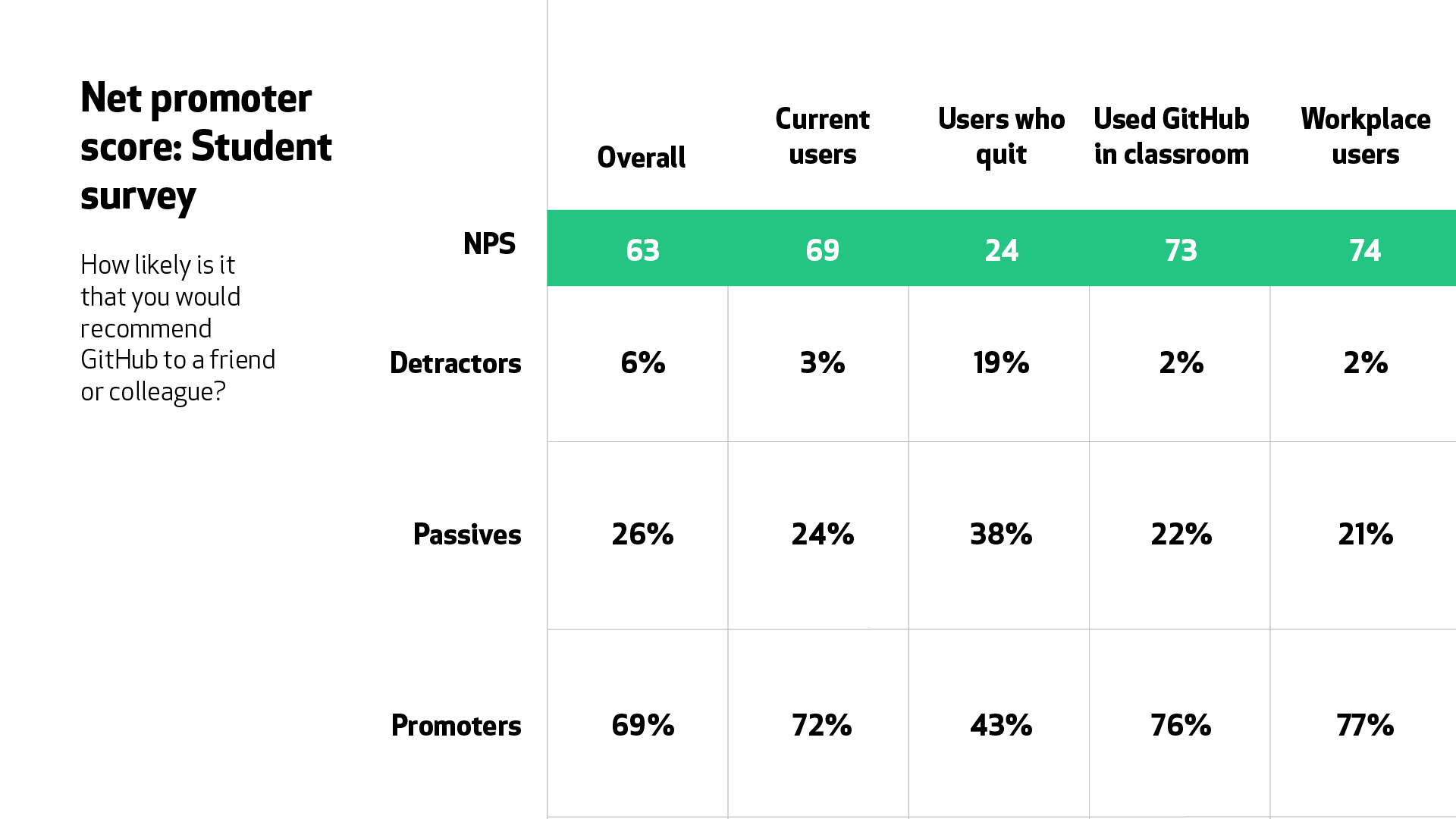
Among teachers, GitHub also has a high NPS of 60.
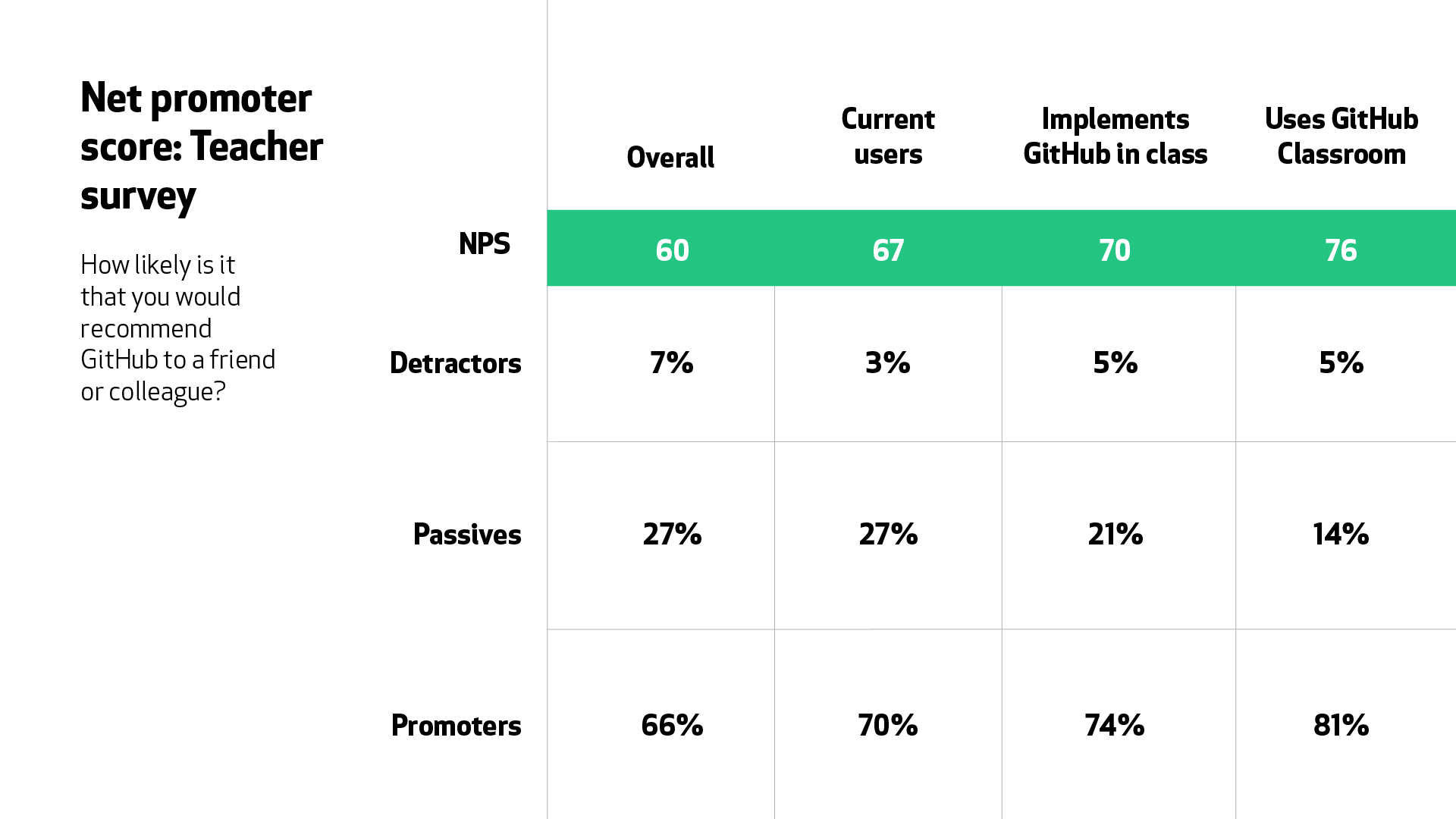
Teachers are equipping students with essential career skills
Teachers bring industry-standard programming languages and version control into their courses. Teachers introduce languages that have wide use in industry and teach the near-universal Git skills that benefit students long after they leave the classroom.
What impact are teachers having? Learn more about teachers’ impact.
Students who use GitHub grow into technology careers
When we looked specifically at students who joined our programs 2014 and 2015, we found that a large portion of those students have now gone on to careers in software development, design, and product management, among others. On top of that, they’re bringing fresh perspectives and tools experience into the workplace. For those who joined in 2014, over half reported having an influence on tool selection.
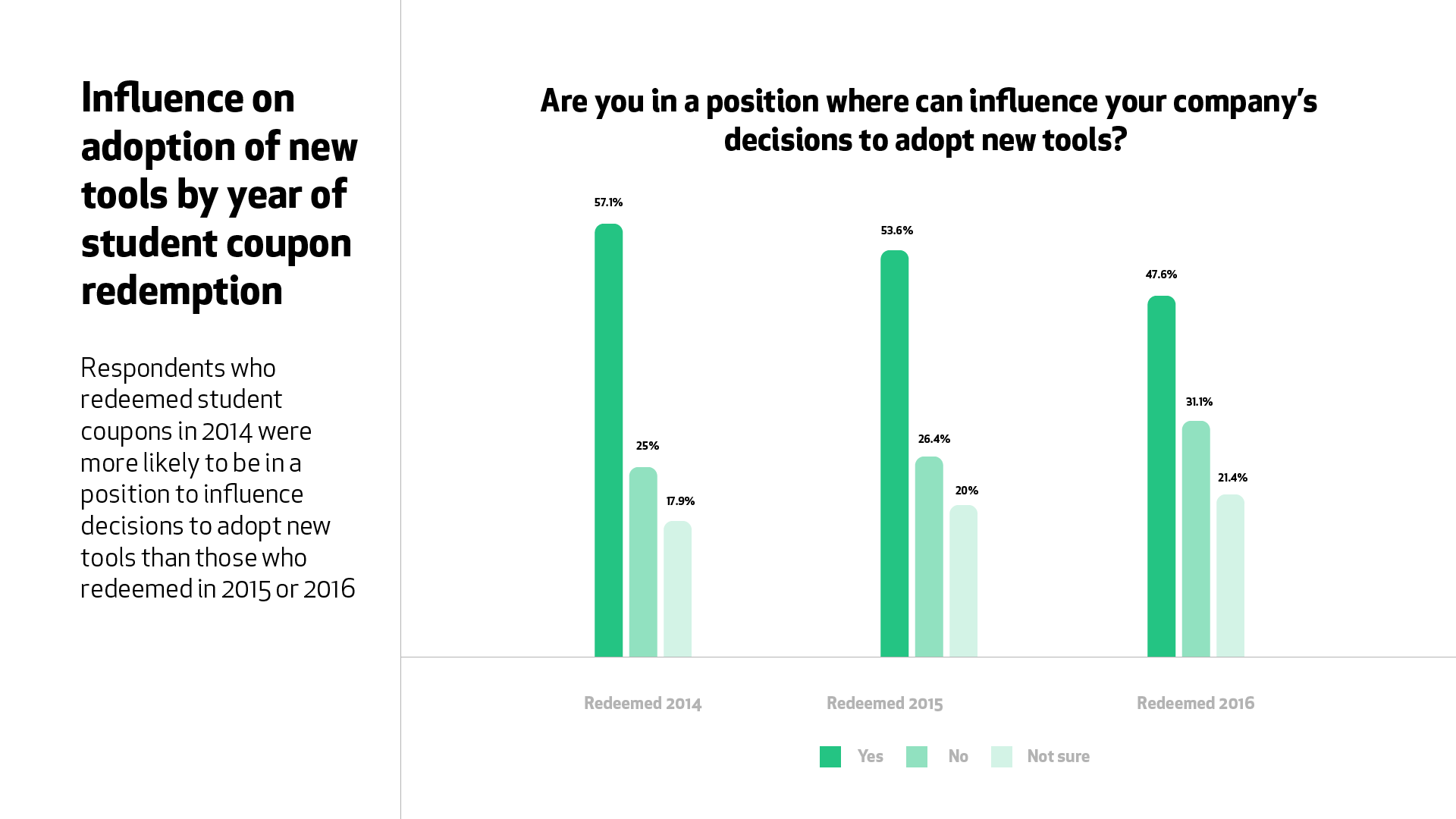
See what else students are up to.
Who we surveyed
To get in touch with people for the survey, we emailed students who joined GitHub’s student programs in 2014, 2015, and 2016, and emailed teachers who joined our educational programs in 2014 and 2016. Students and teachers who participated received a different survey, with questions specific to each audience.
In each survey, we collected some demographic information, such as gender identity and age, and for students specifically, race and ethnicity and highest level of education.
Student and teacher respondents mostly identified as male.
| Female | Male | Non-binary | Self-described | |
|---|---|---|---|---|
| Students | 11.2% | 87.4% | 1.0% | 0.4% |
| Teachers | 6.9% | 93.1% | 0% | 0% |
The average age of student respondents was 26.5 years old, while teachers averaged 41.3 years old.
From students, we learned a bit more about their race and ethnicity, by asking them to choose all that applied:
| Black or of African descent | 3.2% |
|---|---|
| East Asian | 23.6% |
| Hispanic or Latino/Latina | 13.7% |
| Middle Eastern | 5.0% |
| Native American, Pacific Islander, or Indigenous Australian | 1.4% |
| South Asian | 17.7% |
| White or of European descent | 45.3% |
| Other | 0.9% |
We also asked students to tell us about their highest level of education. About half of respondents reported to have a bachelor’s degree and nearly all completed at least some university-level study.
| I never completed any formal education | 0.3% |
|---|---|
| Primary/elementary school | 0.5% |
| Secondary school | 3.6% |
| Some college/university study without earning a degree | 11.9% |
| Associate degree | 2.9% |
| Bachelor’s degree | 52.4% |
| Master’s degree | 20.5% |
| Professional degree (JD, MD, etc.) | 1.3% |
| Other doctoral degree (Ph.D, Ed.D, etc.) | 5.2% |
| Other | 1.6% |
GitHub students become valued professionals
Through our survey, we learned that students aren’t just learning how to use powerful tools for their coursework; students are setting themselves up for success in the workplace.
As a case study, check out our interview earlier this year with Spencer Kaiser, Principal Architect of Emerging Technology at American Airlines. Spencer told us how, as a student, GitHub and the Student Developer Pack gave him the real-world tools to develop his skills beyond the confines of a classroom and textbook. And with those skills, he was able to level up and become a workplace leader. As he told us, “I’m responsible for identifying potential technology that American Airlines could adopt, either software or hardware infrastructure.”
Spencer’s story is an illustration of a progression that shows through in the survey data: GitHub users grow from students and independent learners into teammates and leaders valued for their perspective.
Let’s take a look at how students are using GitHub while in school. For starters, GitHub is showing up to class: over half of the students surveyed reported learning at least a little about GitHub through their coursework, though a plurality (37.3%) noted that this was missing from their curriculum.

Not only are students learning about GitHub in class, but they’re using it on their own too. Over 40% of the respondents said they used GitHub for coursework, even when it wasn’t part of the course itself. And 85.1% of respondents said that they used GitHub for a personal project.
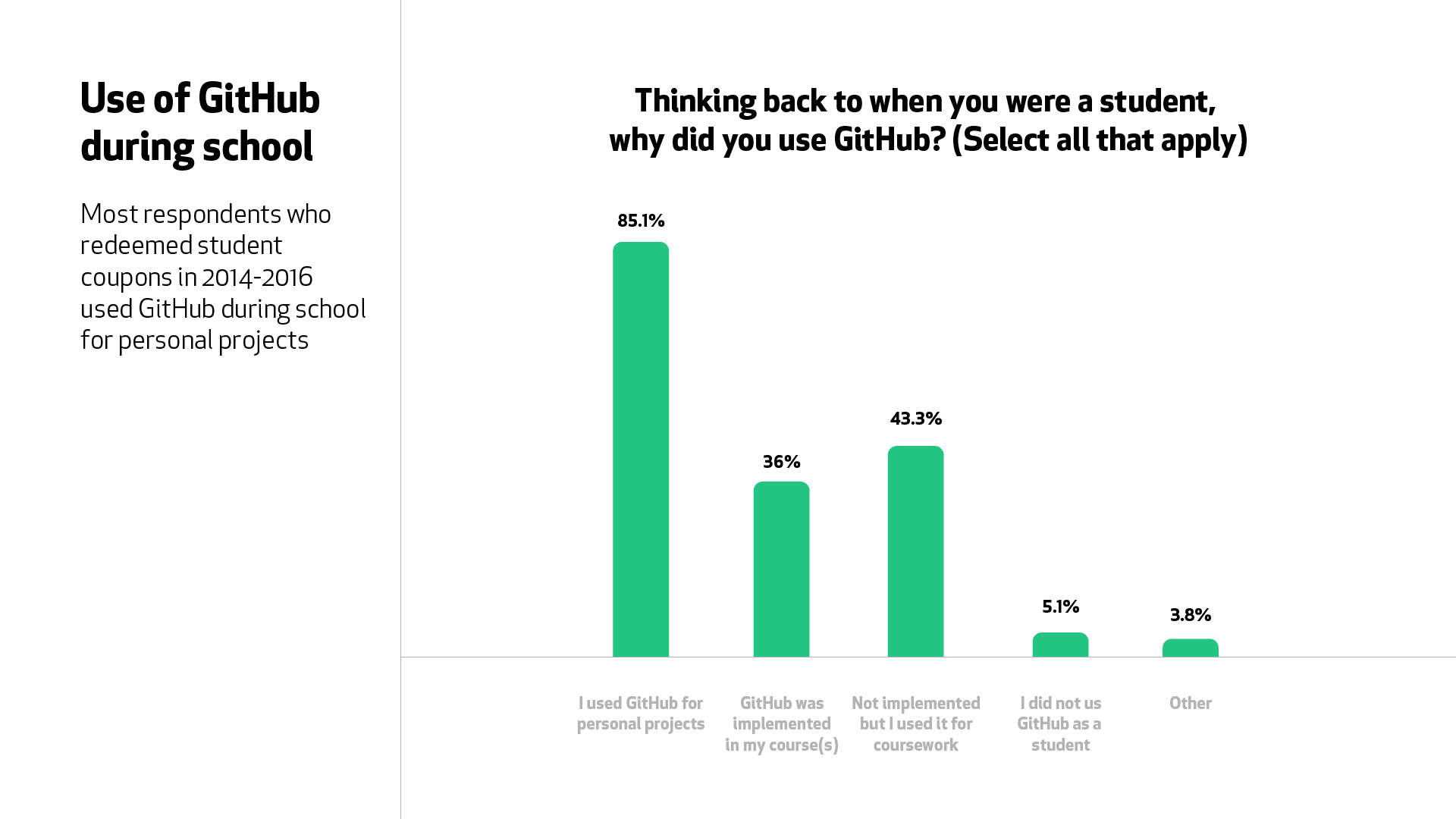
GitHub use among students isn’t an isolated once-a-semester event, either. The overwhelming majority of student respondents said that they use GitHub and that they use it routinely. Nearly half the students reported using GitHub every day, with some using it multiple times a day. Students aren’t leaving it behind when they graduate. They’re finding the rewards in becoming GitHub power users.
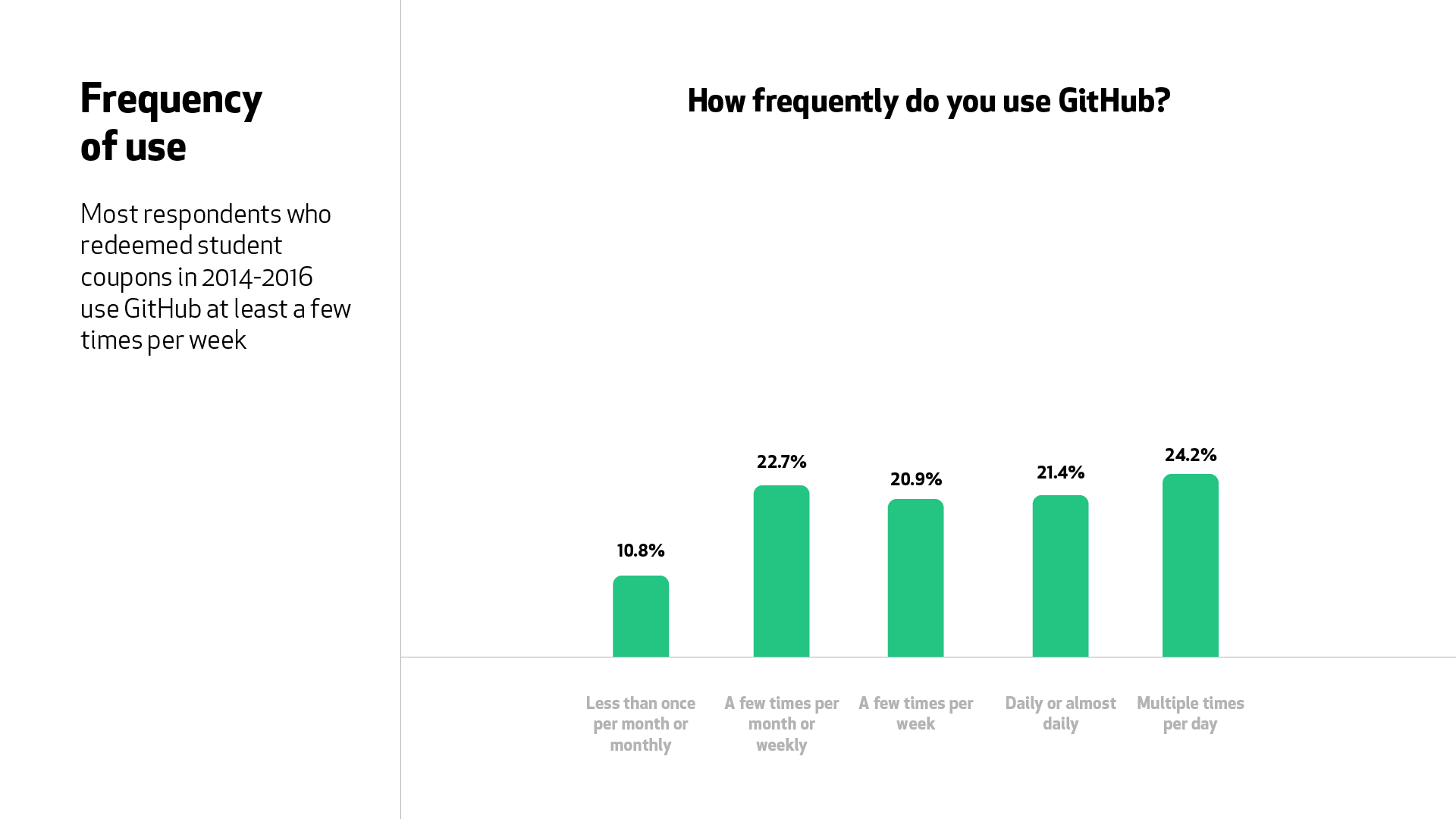
What’s more, students find that they’re sticking with GitHub long-term. Most respondents have been using GitHub for a long time, more than three years.
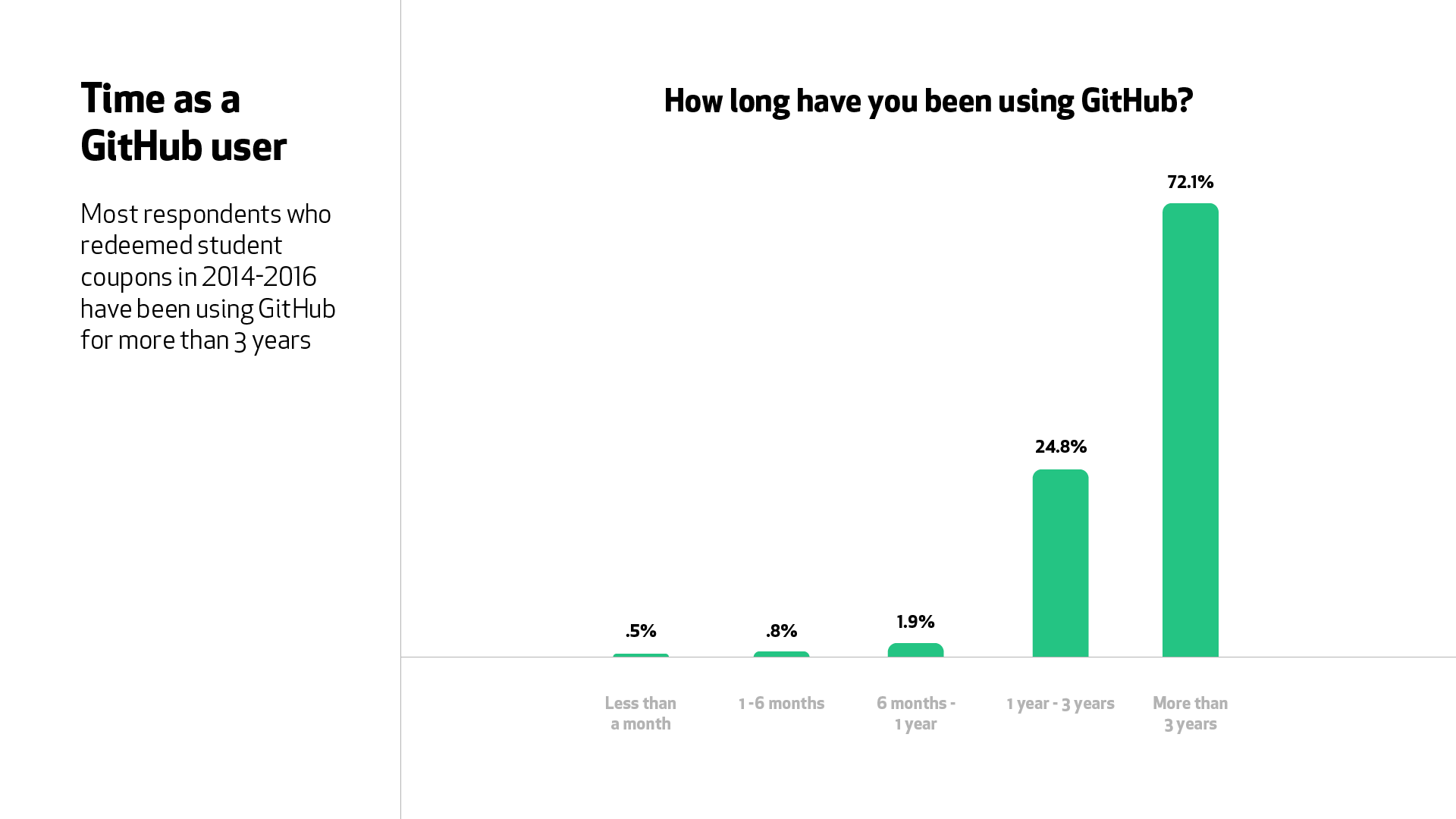
And sticking with GitHub has paid off: a majority of respondents said they consider themselves very familiar with GitHub.
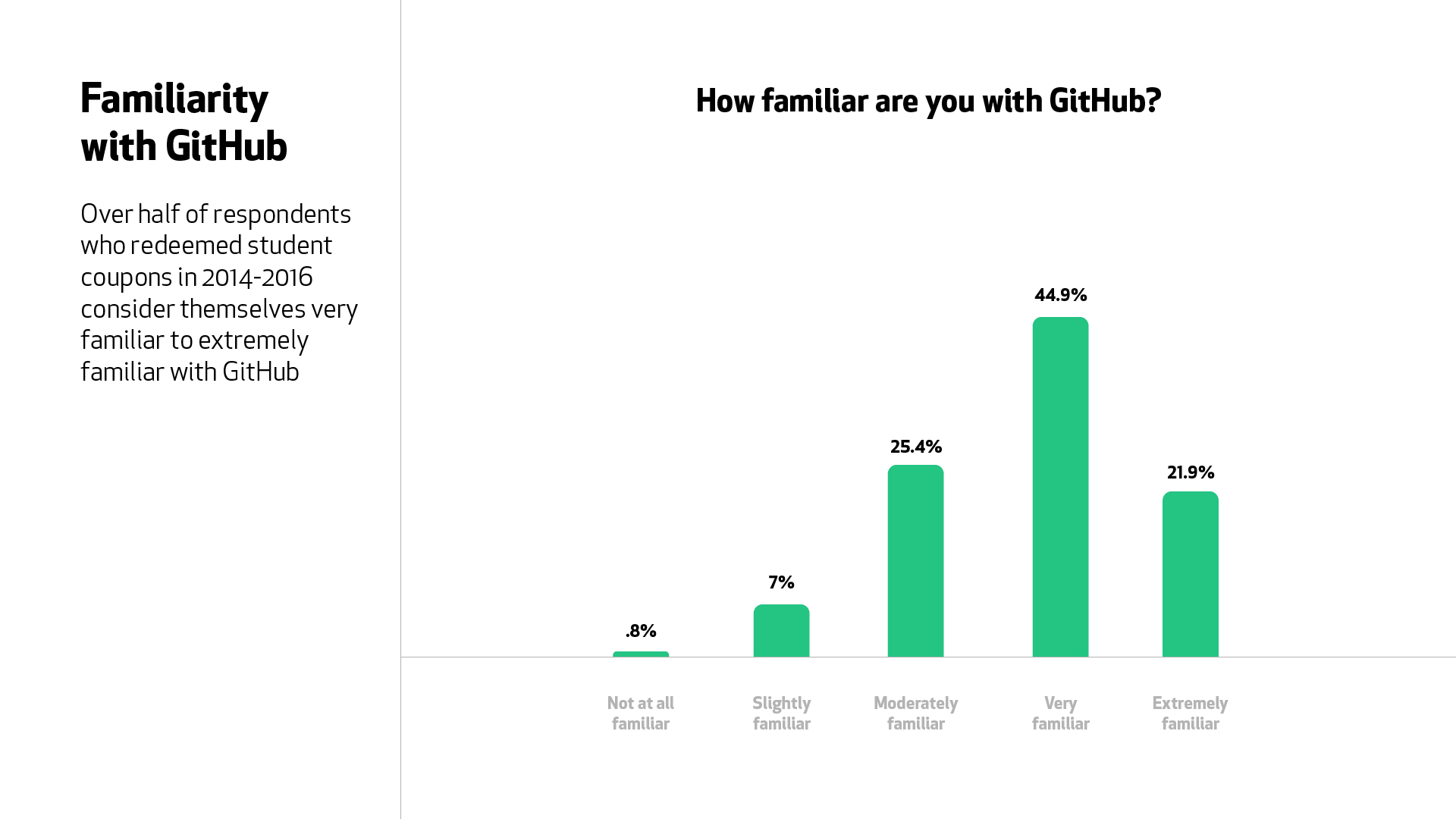
But after classes and internships, what do students have to look forward to? Students who became members of our programs in 2014 and 2015 have largely moved on from their studies into the workplace, giving us an idea of what’s to come for today’s students.
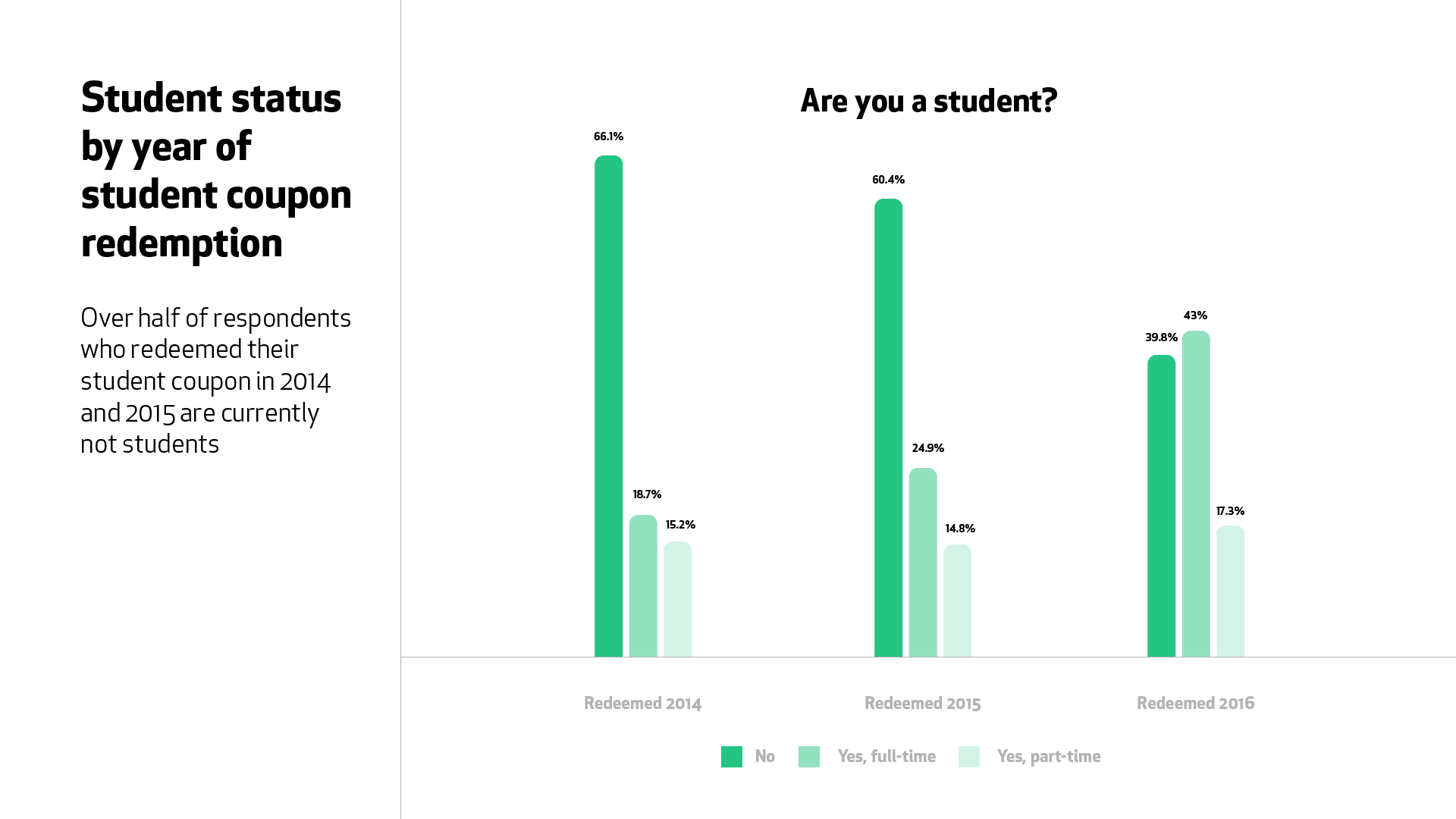
A majority of the respondents reported being in full-time employment. Though developer jobs in the information technology industry are common, that doesn’t tell the whole story. The students in our survey have gone on to a broad range of roles, from developer to product manager to designer to business analyst and they’re bringing their skills to a broad range of industries.
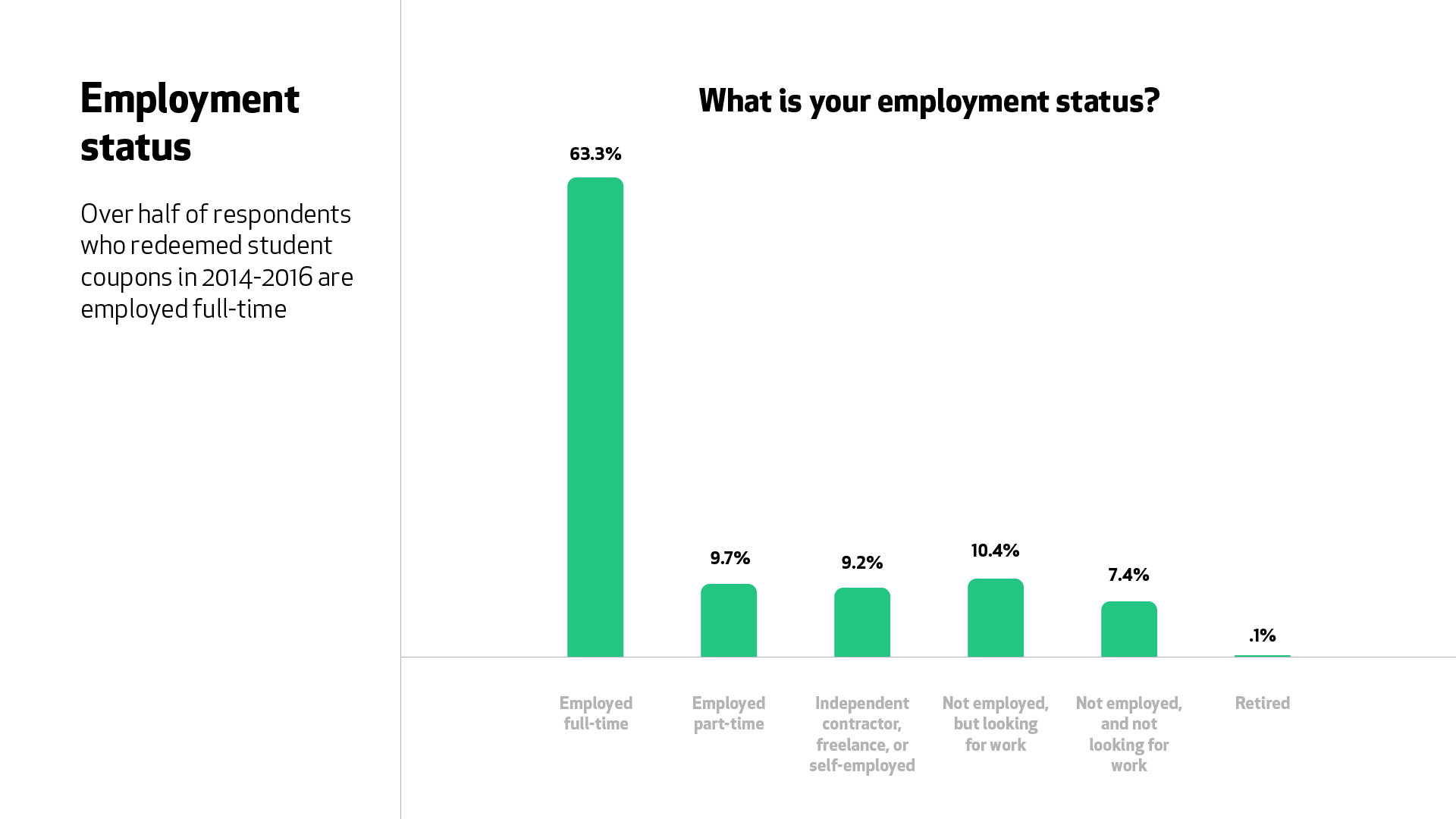
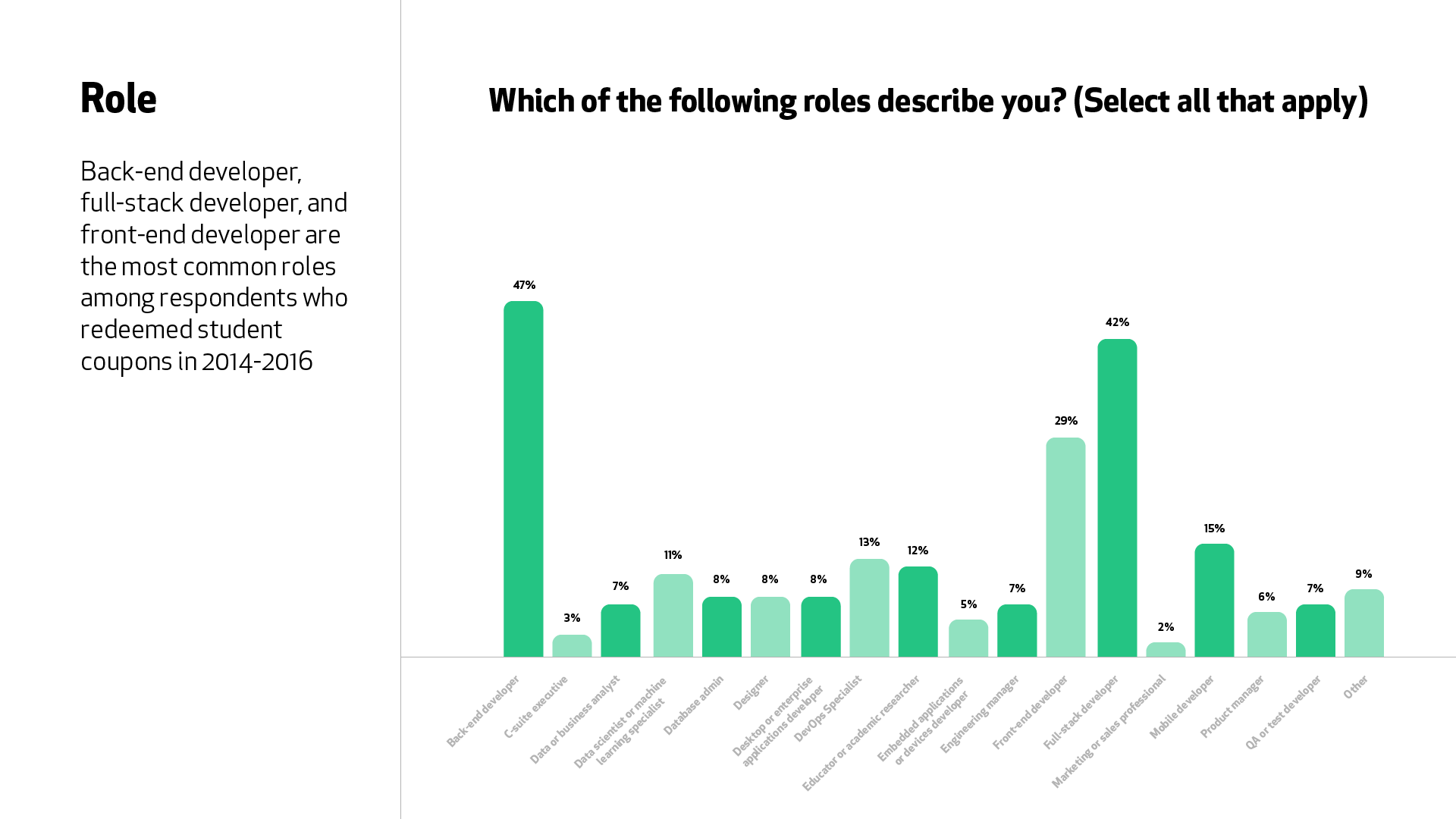
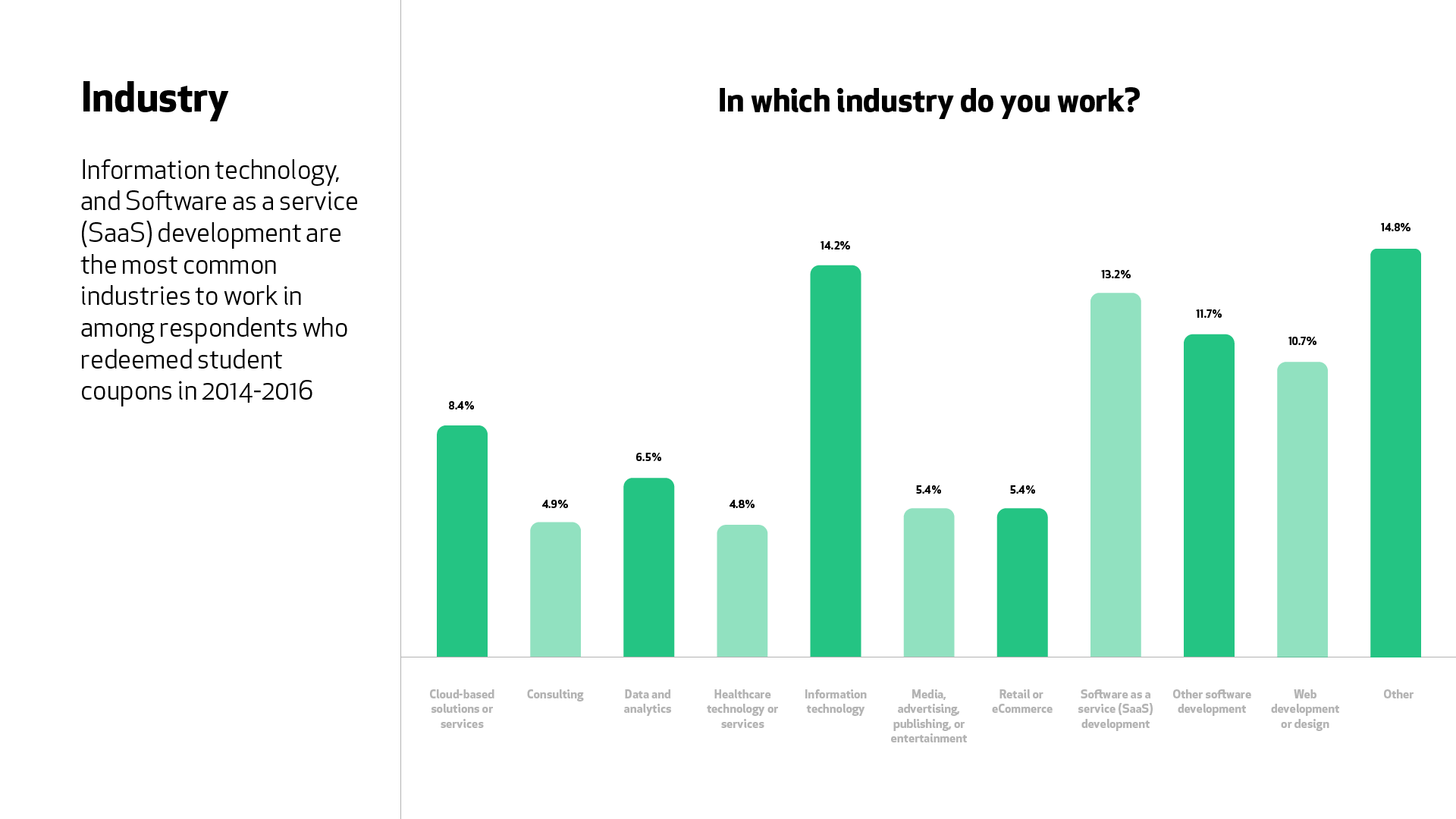
Whatever their industry, GitHub students aren’t just along for the ride. It appears that, as students grow into their roles, they share their perspectives on the tools used in their workplace. Students who joined us in 2014 were most likely to say yes to the question, “Are you in a position where you can influence your company’s decisions to adopt new tools?”

When it comes to choosing tools, survey data also shows that the students who joined GitHub programs go on to use a wide range of tools in the workplace. Through the survey, we took a snapshot of what tools they use. It’s not just about version control: they’re using office suites, issue trackers, IDEs, programming languages, and more. This data helps illustrate the trends in what tools junior developers use and gives current students an idea of what tools they can choose to learn.
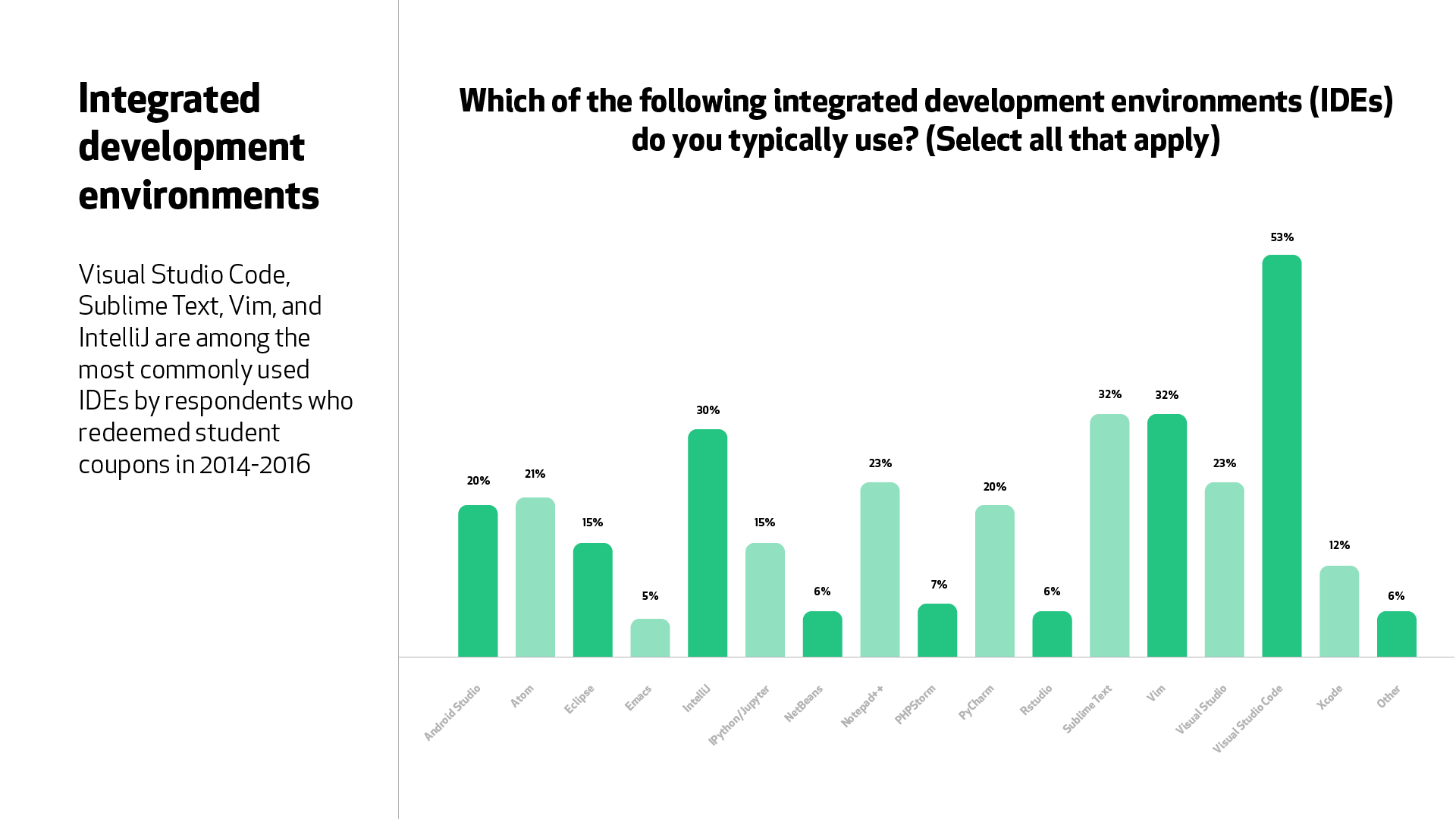

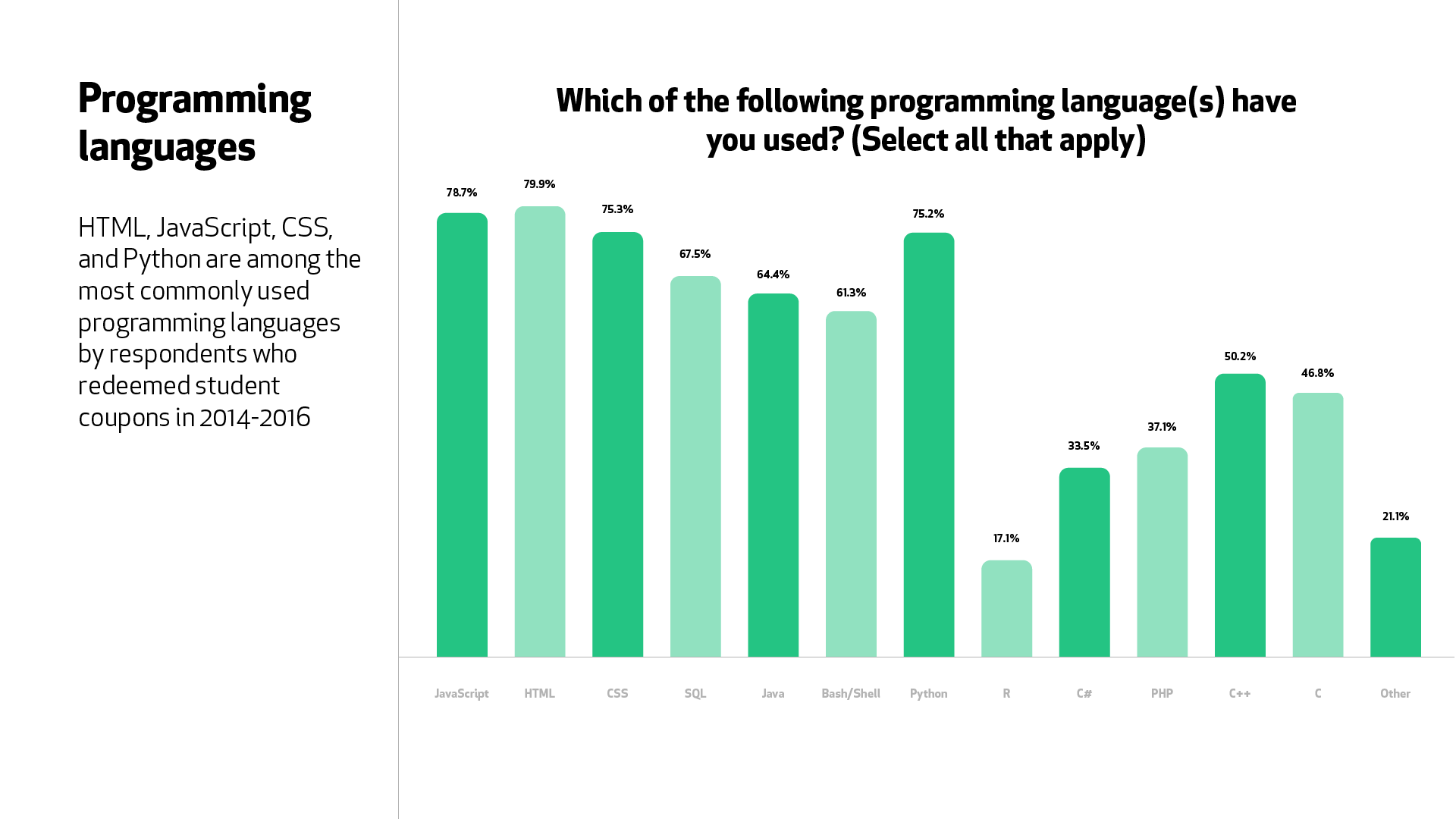
Taken as a whole, the survey responses show that GitHub is an important part of many students’ growth as learners, developers, and professionals.
If you’re a student learning GitHub in the classroom or on your own, then get ahead and sign up for the Student Developer Pack, which gives you free access to dozens of the best tools for developers.
GitHub students learn life skills, not just job skills
Survey responses show that GitHub students aren’t using GitHub because it’s a requirement. They’re finding uses for GitHub for their whole lives, beyond their classrooms and workplaces.
Survey responses from students make it clear that students want to use GitHub. Nearly all current users of GitHub planned to continue to use it (95.6%). Of the respondents who don’t currently use GitHub, nearly all want to use it in the future (46.6%) or are considering it (47.7%).
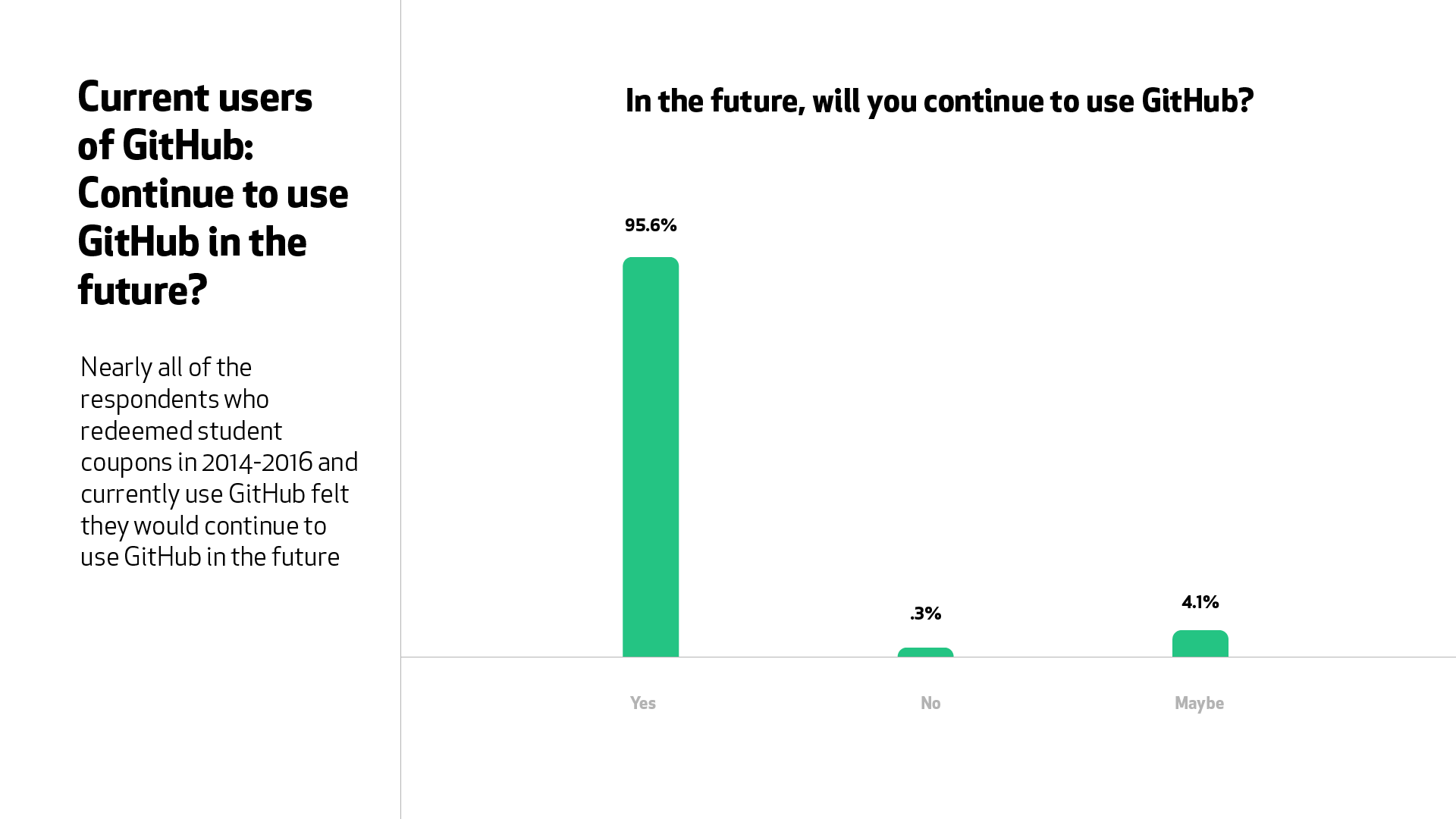
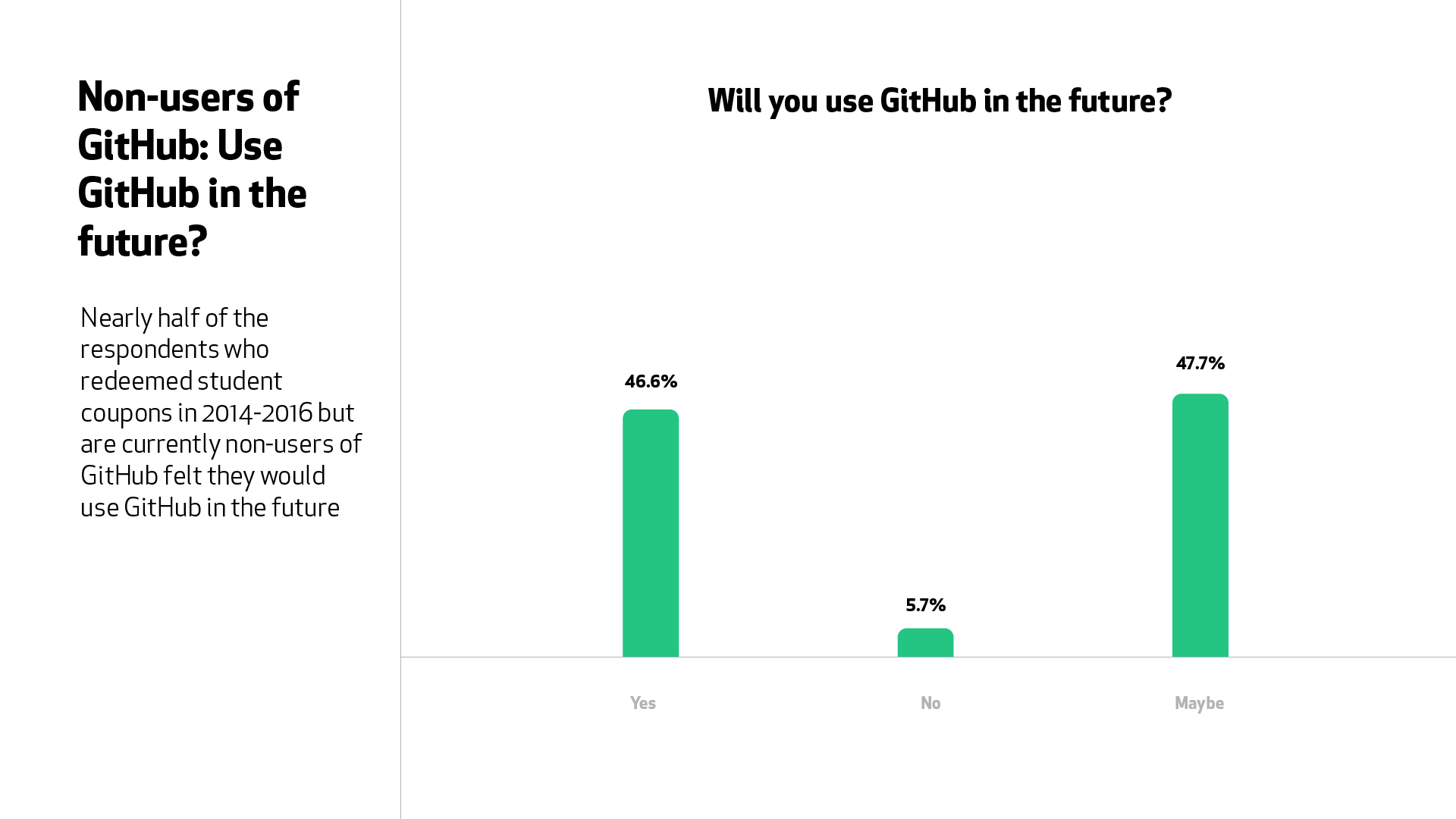
Students see uses for GitHub in their studies, beyond course requirements. Nearly half of students (43.3%) said that they used GitHub for coursework that did not require GitHub. But an overwhelming majority of students who responded to the survey said they used it for personal projects.

Beyond that, nearly half of the people who joined GitHub student programs (49%) noted using GitHub as a portfolio for the work that they had done. To learn more about GitHub as a portfolio, check out the Pins to Win competition we organized this summer, which highlighted the way current students are showing off their work with GitHub.
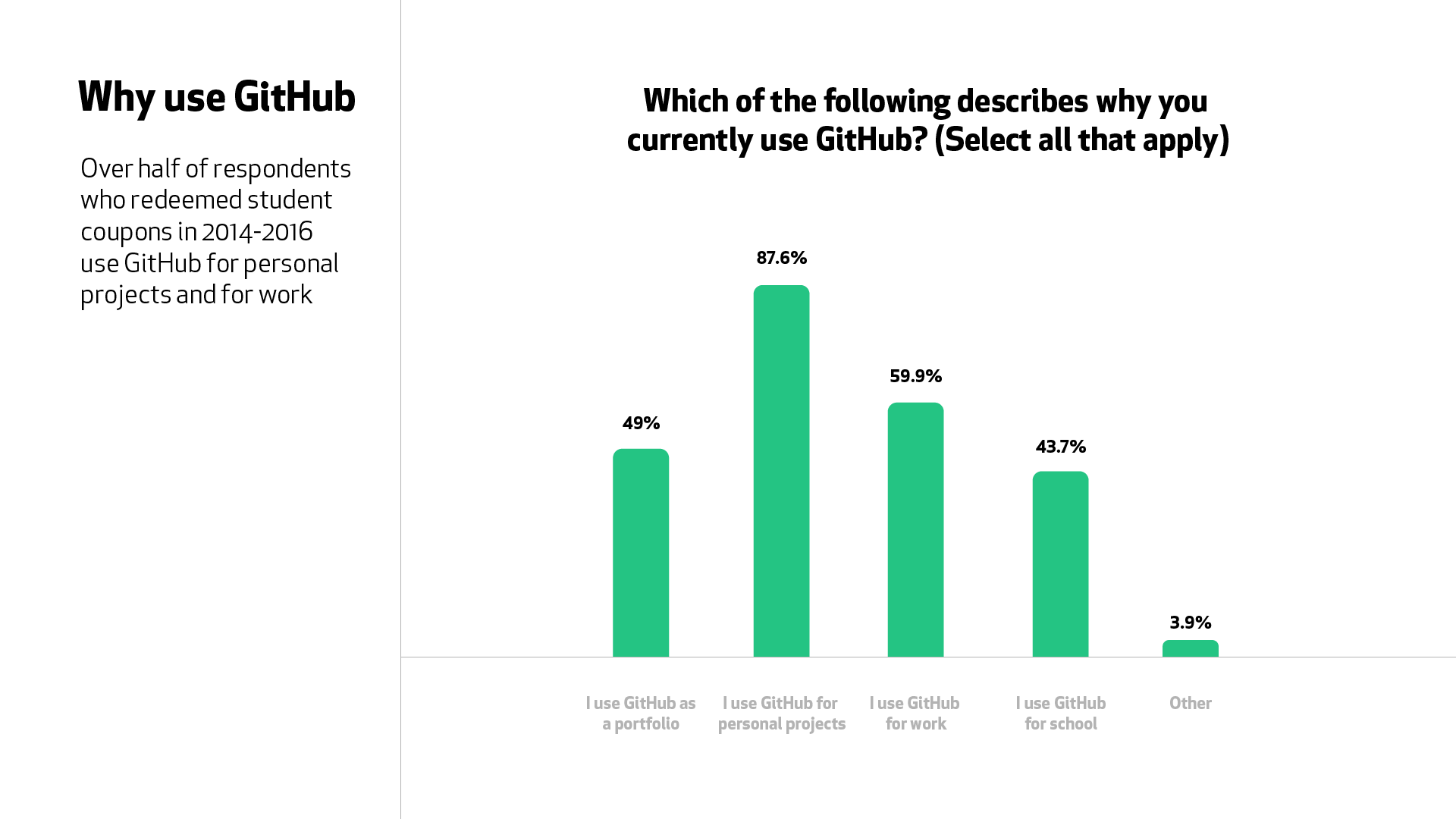
Of course, all work and no play makes a dull Octocat. Students widely reported that they find enjoyment in coding as a hobby, too.
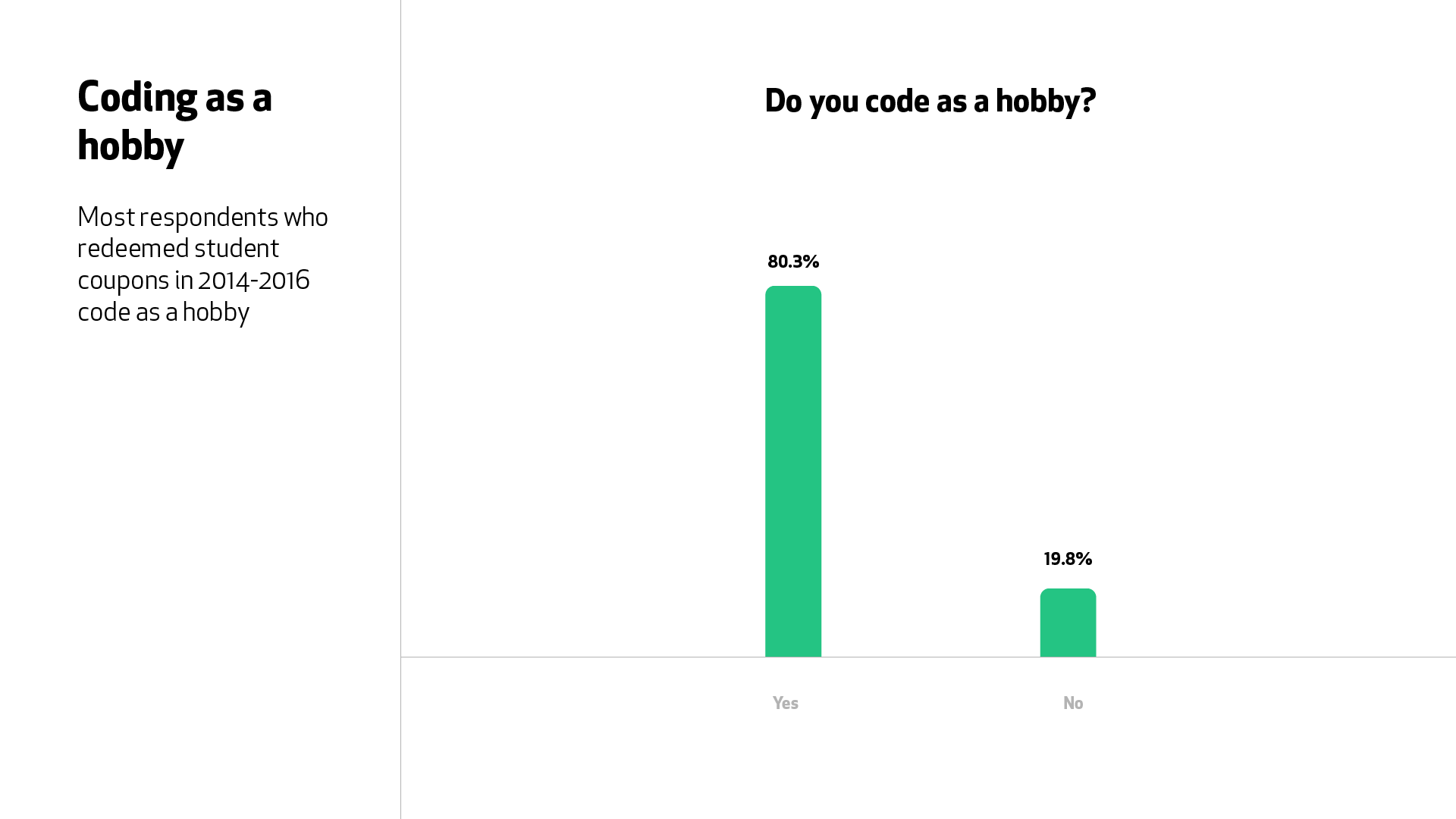
If you’re a student and you want to build your skills beyond the keyboard, then become a GitHub Campus Expert.
GitHub teachers equip students with essential skills
Through our survey, we learned how teachers are preparing students to succeed in classrooms and careers and how they’re using GitHub to do it.
Whether teachers use GitHub in class, they have a big impact on what tools students learn and what skills they develop and that impact persists into students’ careers in industry. For an illustration, look no further than our interview earlier this year with Spencer Kaiser, Principal Architect of Emerging Technology at American Airlines. Spencer told us how, with just a nudge from one of his professors, GitHub and the Student Developer Pack gave Spencer the real-world tools to develop his skills on his own. The survey data shows that many students are having experiences like Spencer’s.
Over half of the students surveyed reported learning at least a little about GitHub through their coursework, though a plurality (37.3%) noted that this wasn’t included in the courses they took.

But even if teachers aren’t choosing to bring GitHub into their classrooms, students aren’t ignoring it. Over 40% of the respondents said they used GitHub for coursework, even when it wasn’t part of the course itself. And 85.1% of respondents said that they used GitHub for a personal project.

By looking at the students who joined GitHub student programs in 2014 and 2015, who have largely moved on from their studies into the workplace, we can see what’s in store for current students.

If past GitHub students are any indication, students are headed toward careers that make use of the skills they acquire in the classroom. Students in the survey have gone on to a broad range of roles, from developer to product manager to designer to business analyst and they’re bringing their skills to a broad range of industries.



Survey data also shows that the students who joined go on to use a wide range of tools in the workplace: office suites, issue trackers, IDEs, programming languages, and version control, just to name a few. When it comes to version control, Git has become a de facto standard.
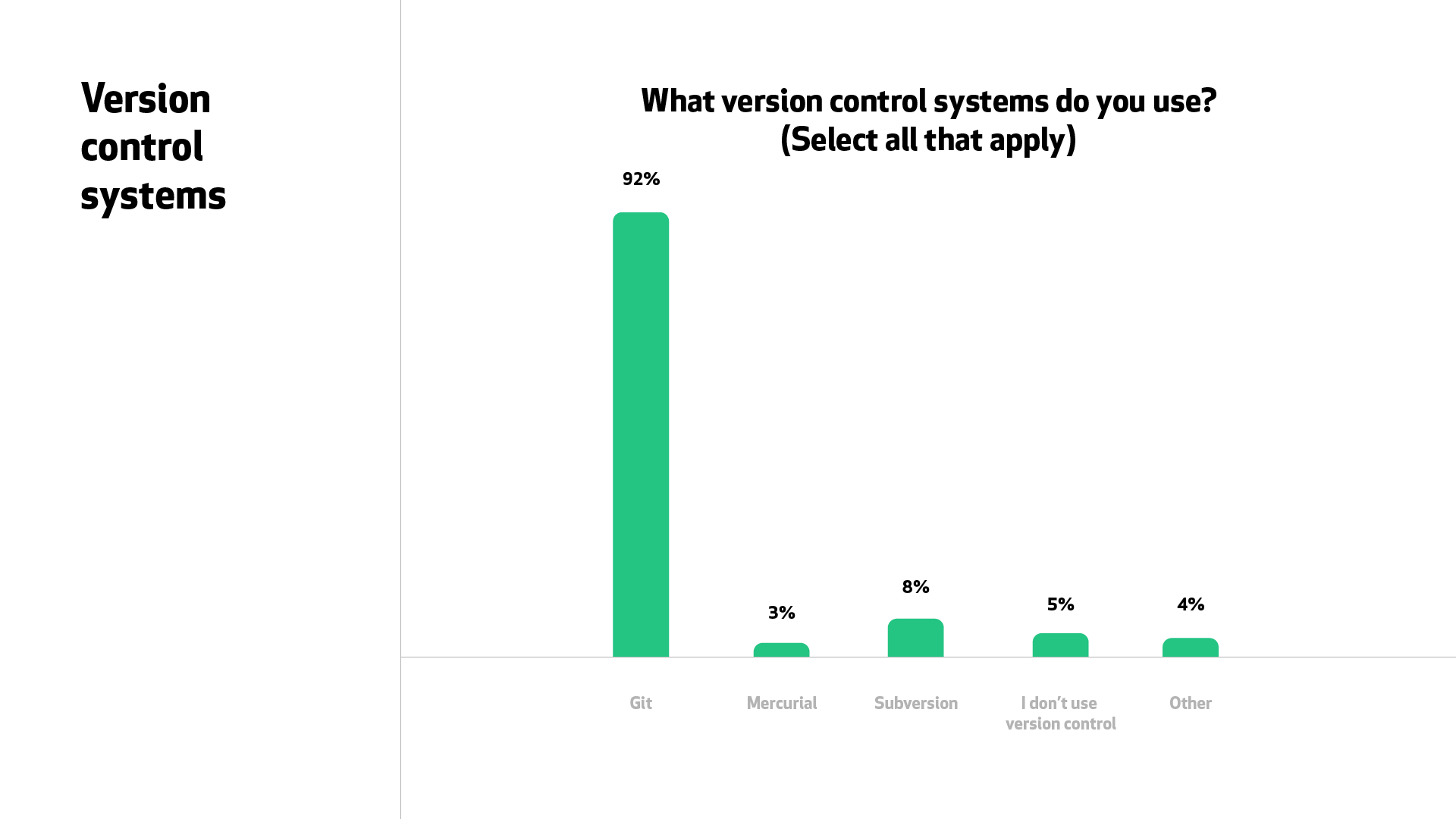

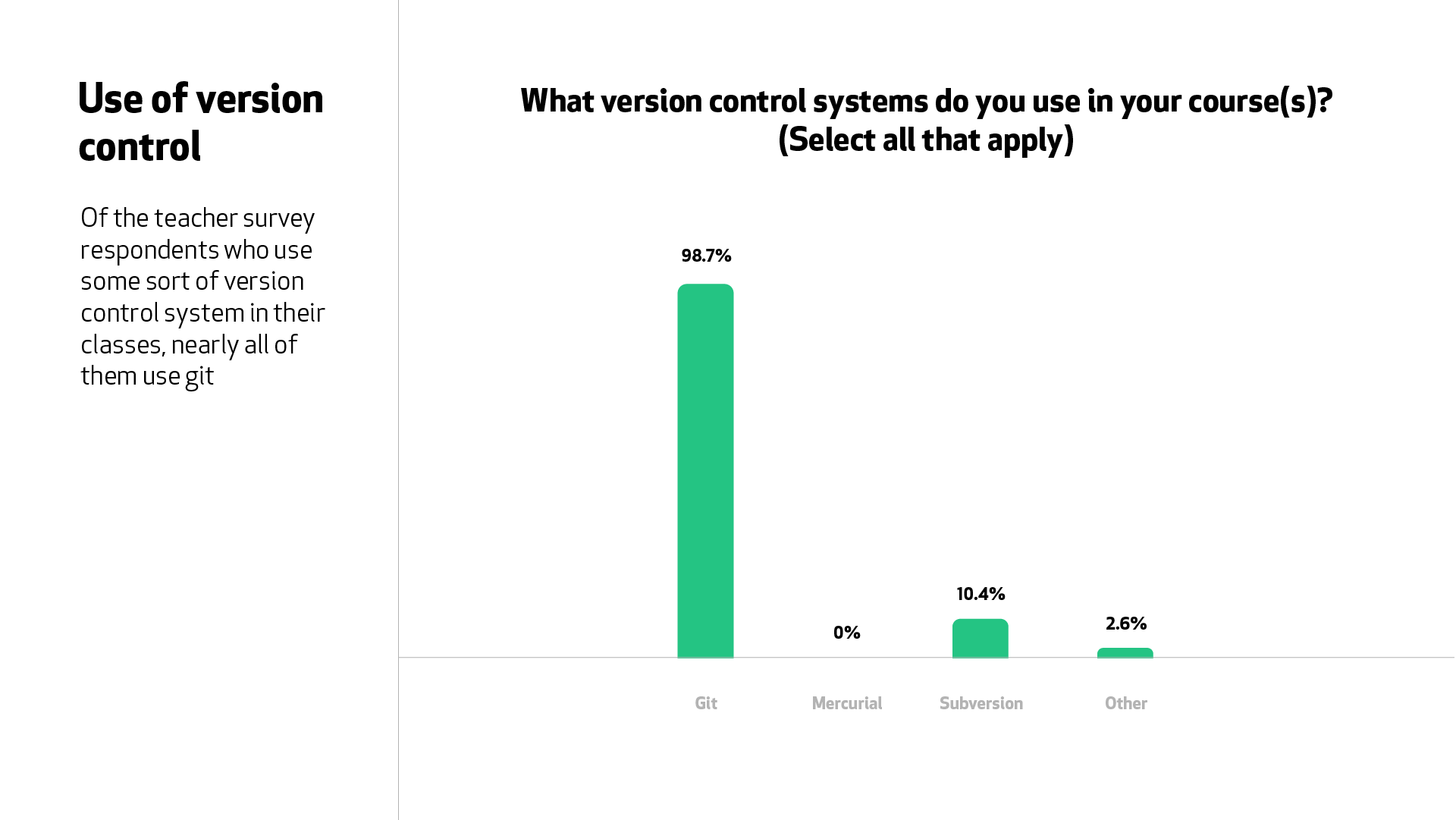
On top of that, coverage of essential features of Git, such as commits, branches, and pushing and pulling, are being covered in class.
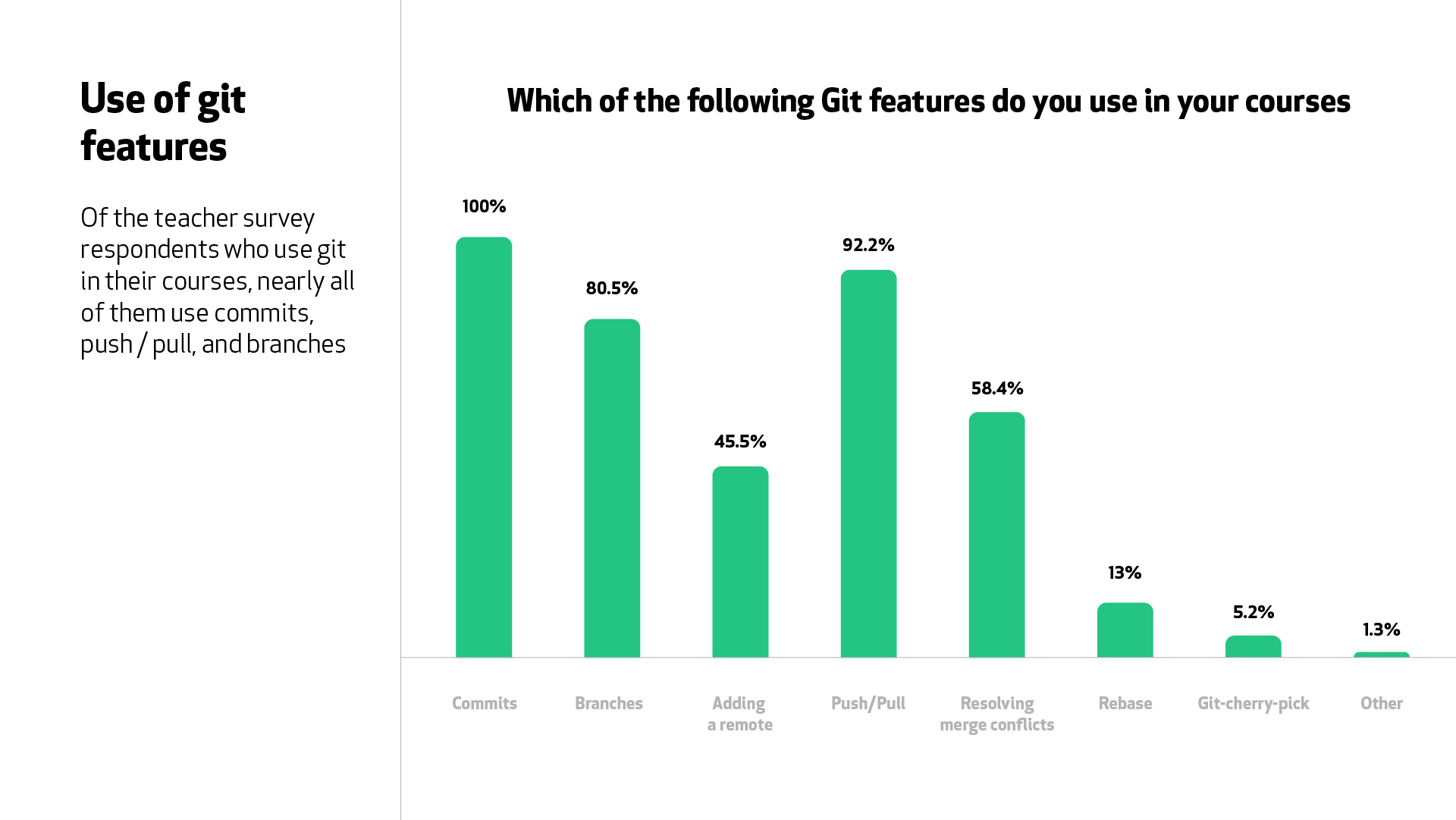
When it comes to GitHub, adoption is lower, though still common. Over half (62%) of the teachers who responded to the survey use GitHub in their courses and of those who don’t, most would like to. Of the teachers that do use GitHub, a majority (63.6%) are using GitHub Classroom—a tool that helps educators with the workflow of teaching with GitHub—to implement GitHub in their courses.
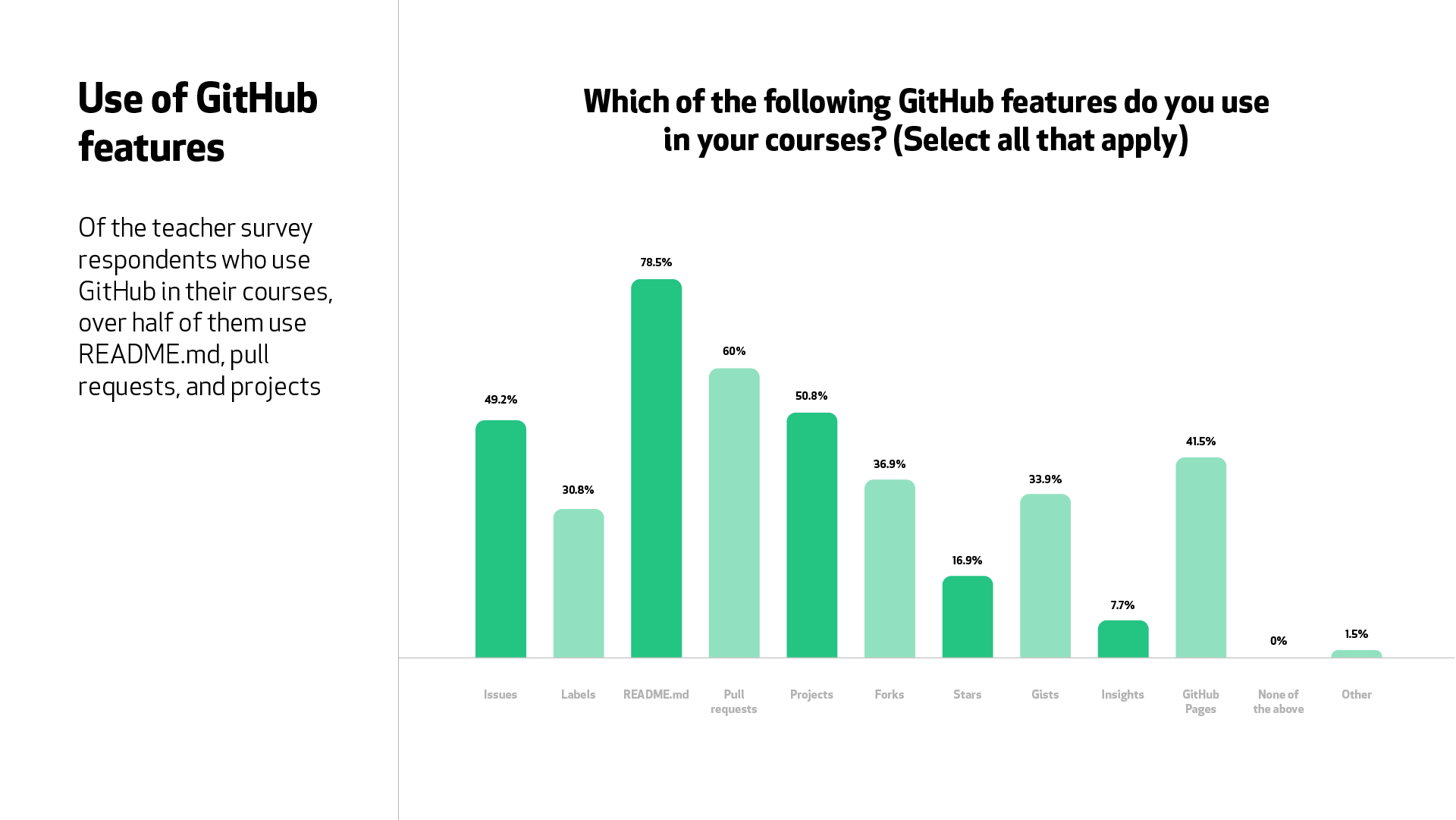
There’s good news for teachers that plan to implement GitHub in the future: about half (50.8%) of teachers said it was easy to implement GitHub in the classroom, and nearly all of the teachers who use it now plan to continue to use it in the future.
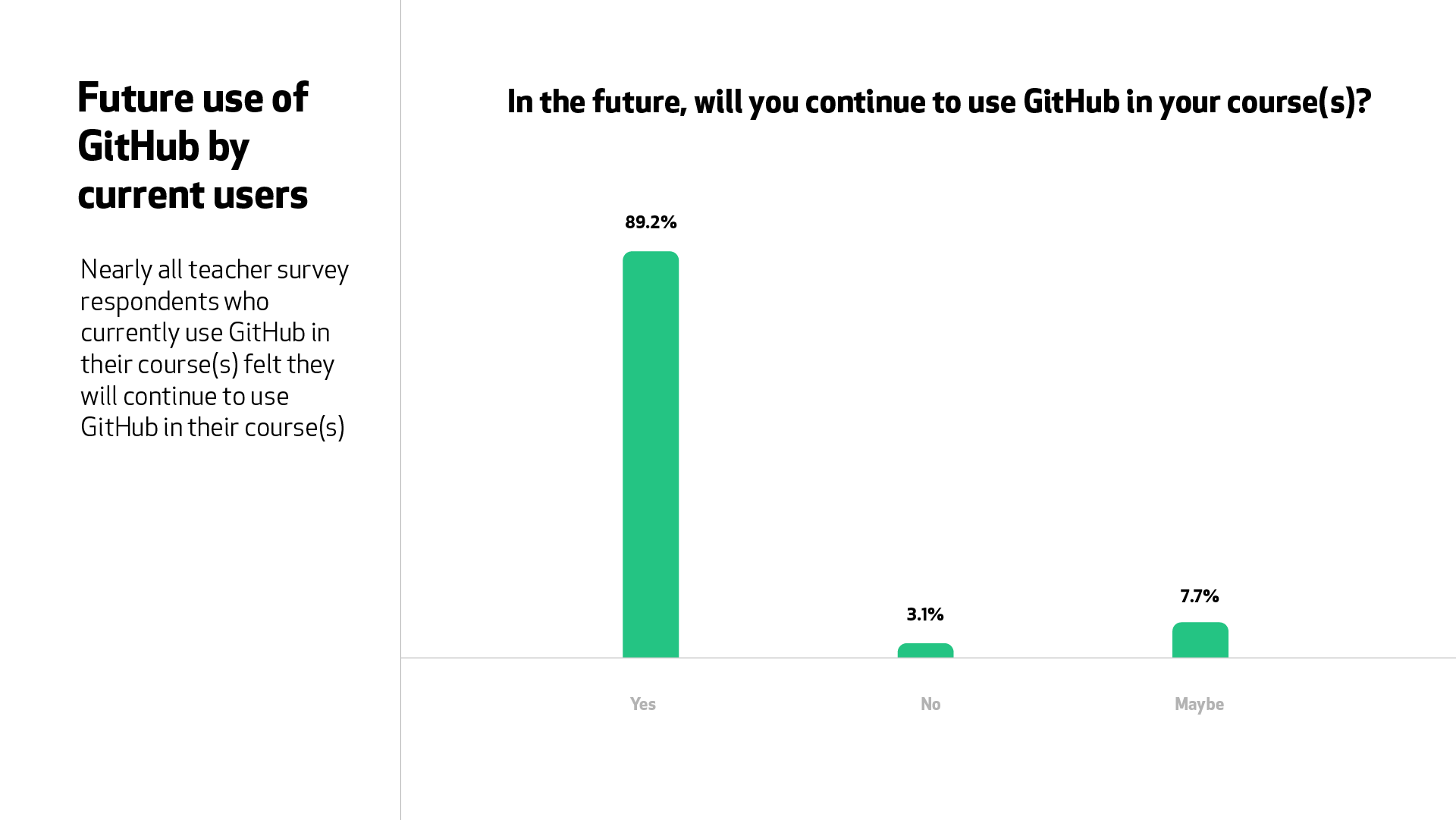
This lines up with teachers saying they would recommend GitHub to others. Across all teachers who responded to our survey, GitHub got a high net promoter score of 60. But with teachers who used GitHub in their courses or used GitHub Classroom, scores went even higher, to 70 and 76, respectively.

Taken together, this survey data shows that teachers can have a big impact on the skills students acquire in their coursework, but it also shows that there’s more to using GitHub in the classroom than a demo or an assignment that marks the “version control” checkbox. To see how teachers are embedding GitHub into their instruction, check out this case study, which shows how Dr. Shane Wilson at Ulster University used GitHub and continuous integration, to raise students’ grades and boost student feedback.
If you’re a teacher and you want to bring GitHub into your classroom, then get started with GitHub Classroom.
Teachers are trendsetters in tech
Teachers aren’t passively chasing trends in technology, they’re a part of the trendsetting process, in part through the tools they select and in part by preparing their pupils to learn on their own.
To highlight one set of skills in particular, take a look at programming language use. Teachers aren’t playing with toys. They’re teaching the languages that students go on to use in the workplace, such as Python, HTML, CSS, and JavaScript.


We asked similar questions about tools, such as IDEs. Here are the IDEs that students are using in the workplace. When we asked teachers what IDEs they used in their classrooms, they had similar proportional responses. Teachers, almost as much as student respondents, have put IDEs like Visual Studio Code into their toolbox.

This trendsetting process is not a one-way street, though. Students are learning on their own, through hackathons, bootcamps, and open source contribution.
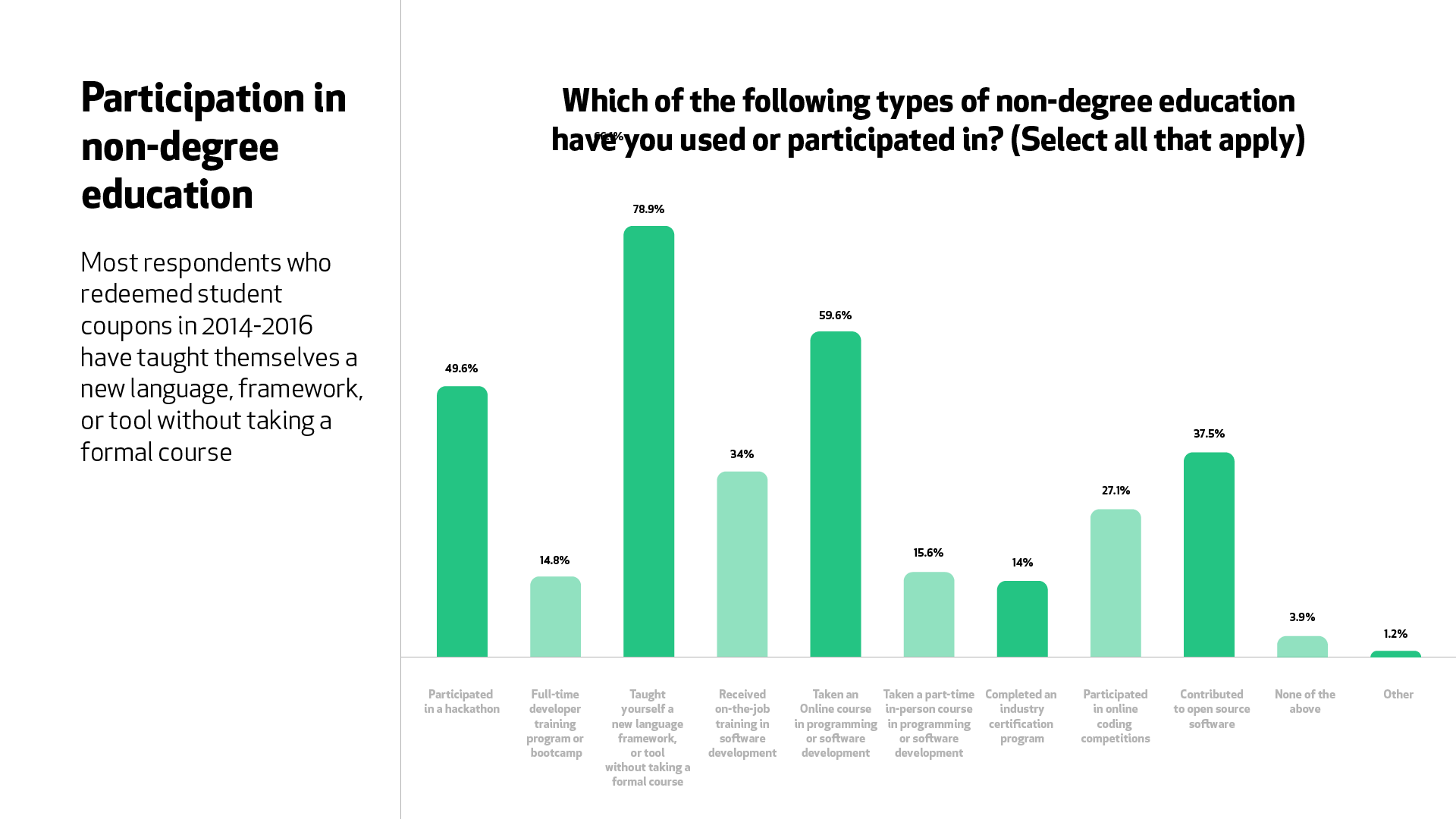
Teachers may be well-served by encouraging their students to seek out hackathons, for example. Major League Hacking conducted a survey that showed students learn skills in hackathons that they bring back to their coursework.
Learn more
The Classroom Report for 2019 shows that GitHub is in the classroom and the workplace, now and in the future. Teachers are already using GitHub in the classroom and more plan to teach it in a coming semester. For students, if GitHub isn’t an essential tool today, it will be as they continue their studies and enter the workplace.
Want to learn more about how GitHub matters to students and teachers? The GitHub blog is home to many in-depth looks at how teachers and students are using GitHub to teach better and learn more.
Students
Sharing data for further research
In the spirit of furthering research on technical education, we're sharing the anonymized data sets we collected. Those files are under an MIT license, along with for a key for understanding our analysis, in GitHub Education’s repository.
